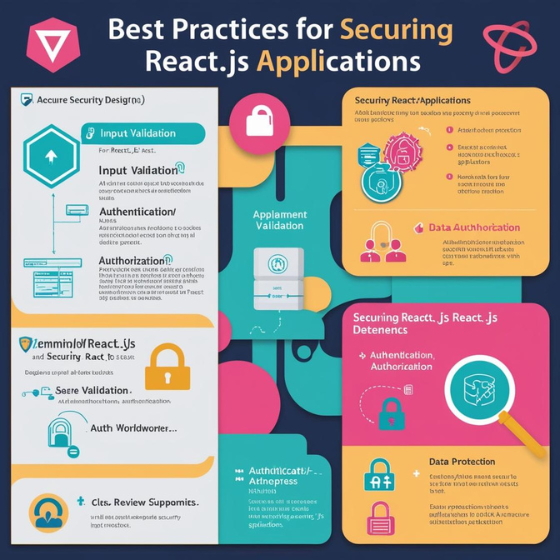How to Secure React.js Applications
In the rapidly evolving digital landscape, web applications are increasingly becoming targets for cyberattacks. While React.js offers developers an efficient way to build dynamic user interfaces, security concerns often take a backseat in the development process. Failing to secure your React.js applications can lead to data breaches, compromised user trust, and significant financial losses.
So, how do you ensure your React.js applications remain safe from threats? This blog will guide you through how to secure React.js applications, offering actionable tips, best practices, and insights into building secure and robust web solutions.
Introduction: Why Securing React.js Applications Matters
Did you know that cyberattacks increased by 38% globally in 2023? With web applications being prime targets, it’s crucial to integrate security into every stage of development. React.js applications, known for their performance and flexibility, require robust security measures to protect sensitive user data and application integrity.
In this guide, we’ll explore how to secure React.js applications by implementing preventive strategies and leveraging best practices. By the end, you’ll be equipped to fortify your applications and maintain user trust.
Understanding Common Security Vulnerabilities in React.js Applications
Before diving into solutions, it’s essential to identify the most common threats that React.js applications face:
1. Cross-Site Scripting (XSS)
- What it is: Attackers inject malicious scripts into web pages viewed by other users.
- Impact: Can lead to session hijacking, data theft, or defacement of your application.
2. Cross-Site Request Forgery (CSRF)
- What it is: Exploits authenticated sessions, tricking users into performing unintended actions.
- Impact: Can manipulate sensitive actions like fund transfers or account modifications.
3. Insecure Dependencies
- What it is: Third-party libraries with vulnerabilities in your application.
- Impact: Attackers exploit these to infiltrate or compromise your application.
4. Data Leakage
- What it is: Unintentional exposure of sensitive information through errors or misconfigurations.
- Impact: Leads to loss of user trust and regulatory non-compliance.
By understanding these vulnerabilities, developers can proactively design their applications with security in mind.
Best Practices for Securing React.js Applications
Securing React.js applications requires a multi-layered approach. Here are some of the most effective strategies:
1. Sanitize and Validate Inputs
- Always sanitize user inputs to prevent malicious data injection.
- Use libraries like
DOMPurifyto clean HTML content before rendering.
2. Implement Content Security Policy (CSP)
- Define trusted sources for scripts, styles, and other resources.
- Use a strict CSP header to mitigate XSS attacks.
3. Avoid Inline JavaScript
- Refrain from embedding inline JavaScript in your application.
- Leverage external scripts and ensure they are securely sourced.
4. Secure API Calls
- Use HTTPS to encrypt data transmission.
- Implement OAuth or API keys for authentication.
5. Enable Strict Mode
- Use React’s Strict Mode during development to highlight potential vulnerabilities.
Securing Authentication and Authorization
Authentication and authorization are critical components of application security. Here’s how you can enhance these processes in React.js:
1. Use Secure Authentication Protocols
- Implement multi-factor authentication (MFA).
- Leverage libraries like
Auth0orFirebase Authentication.
2. Protect JWT Tokens
- Store tokens securely using HTTP-only cookies.
- Avoid localStorage for sensitive tokens as it’s vulnerable to XSS attacks.
3. Role-Based Access Control (RBAC)
- Define user roles and permissions to prevent unauthorized access.
- Ensure backend validation of user privileges.
How Sodio Secures React.js Applications
At Sodio, we prioritize security in every stage of development. Here’s how we ensure robust protection for our React.js projects:
1. Comprehensive Security Audits
- Regularly assess codebases for vulnerabilities.
- Perform penetration testing to identify and mitigate risks.
2. Integration of Secure Coding Practices
- Adhere to OWASP guidelines during development.
- Use linting tools to detect insecure code patterns.
3. Secure Hosting and Deployment
- Host applications on platforms with built-in security measures.
- Use CI/CD pipelines to automate security checks during deployment.
4. Case Study: E-Commerce Application
- Challenge: Preventing XSS and CSRF attacks in a high-traffic e-commerce platform.
- Solution: Implemented CSP, input sanitization, and token-based authentication.
- Result: Improved application security and user trust, reducing support queries by 40%.
Learn more about our secure development process on our React.js development services page.
Tools and Libraries to Enhance Security
Leverage these tools to bolster the security of your React.js applications:
- Helmet.js: Adds HTTP headers to secure the app against attacks like XSS.
- Redux Middleware Security: Prevent unauthorized state changes with middleware.
- Snyk: Detects vulnerabilities in dependencies.
- Cypress: Automates end-to-end testing, including security checks.
These tools not only enhance security but also streamline the development process.
Maintaining Security Post-Deployment
Securing your React.js application doesn’t end with deployment. Continuous monitoring and updates are vital:
- Monitor Logs: Regularly check logs for suspicious activity.
- Apply Updates: Stay updated with the latest security patches for dependencies.
- Conduct Regular Audits: Schedule security audits to identify new vulnerabilities.
Conclusion: Building Secure and Reliable React.js Applications
Securing React.js applications is an ongoing process that requires vigilance and a proactive approach. From sanitizing inputs to implementing robust authentication protocols, every step contributes to building applications that users can trust.
At Sodio, we specialize in creating secure and scalable React.js solutions tailored to your business needs. Whether it’s fortifying an existing application or building a secure platform from scratch, our team has the expertise to deliver excellence.
? Get in touch with our experts today to learn more about how we secure React.js applications.
? Explore our React.js services to see how we can help you create secure, high-performing applications.







